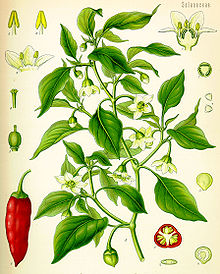- Jalapeño
-
Jalapeño 
Heat Medium (SR: 2,500-10,000) The jalapeño (
 /ˌhæləˈpiːnjoʊ/, Spanish: [xalaˈpeɲo]) is a medium-sized chili pepper that has a warm, burning sensation when eaten. A mature jalapeño fruit is 2–3½ inches (5–9 cm) long and is commonly picked and consumed while still green, but occasionally it is allowed to fully ripen and turn crimson red. It is a cultivar of the species Capsicum annuum originating in Mexico, which is a bush that grows 2–4 feet (60–120 cm) tall. It is named after Xalapa, Veracruz, where it was traditionally cultivated. About 160 square kilometres (40,000 acres) are dedicated for the cultivation in Mexico, primarily in the Papaloapan river basin in the north of the state of Veracruz and in the Delicias, Chihuahua area. Jalapeños are cultivated on smaller scales in Jalisco, Nayarit, Sonora, Sinaloa, and Chiapas.
/ˌhæləˈpiːnjoʊ/, Spanish: [xalaˈpeɲo]) is a medium-sized chili pepper that has a warm, burning sensation when eaten. A mature jalapeño fruit is 2–3½ inches (5–9 cm) long and is commonly picked and consumed while still green, but occasionally it is allowed to fully ripen and turn crimson red. It is a cultivar of the species Capsicum annuum originating in Mexico, which is a bush that grows 2–4 feet (60–120 cm) tall. It is named after Xalapa, Veracruz, where it was traditionally cultivated. About 160 square kilometres (40,000 acres) are dedicated for the cultivation in Mexico, primarily in the Papaloapan river basin in the north of the state of Veracruz and in the Delicias, Chihuahua area. Jalapeños are cultivated on smaller scales in Jalisco, Nayarit, Sonora, Sinaloa, and Chiapas.Contents
Overview
A jalapeño plant with pods. The purple strips on the stem are anthocyanin, due to the growth under blue-green spectrum fluorescent lighting.
The jalapeño is variously named in Mexico as huachinango and chile gordo. The cuaresmeño closely resembles the jalapeño. The seeds of a cuaresmeño have the heat of a jalapeño, but the flesh has a mild flavor close to a green bell pepper.
As of 1999[update], 5,500 acres (22 km2) in the United States were dedicated to the cultivation of jalapeños. Most jalapeños are produced in southern New Mexico and western Texas.
Jalapeños are a pod type of Capsicum. The growing period is 70–80 days. When mature, the plant stands two and a half to three feet tall. Typically, a plant produces 25 to 35 pods. During a growing period, a plant will be picked multiple times. As the growing season ends, jalapeños start to turn red, which may make them less desirable. Jalapeños thrive in a number of soil types and temperatures, provided they have adequate water. Once picked, individual peppers may turn to red of their own accord. The peppers can be eaten green or red.
Jalapeños have 2,500 - 8,000 Scoville heat units. Compared to other chilis, the jalapeño has a heat level that varies from mild to hot depending on cultivation and preparation. The heat, caused by capsaicin and related compounds, is concentrated in the membrane (placenta) surrounding the seeds. Handling fresh jalapeños may cause skin irritation. Some handlers wear latex or vinyl gloves while cutting, skinning, or seeding jalapeños. When preparing jalapeños, hands should not come in contact with the eyes, as this leads to painful burning and redness.
Jalapeño is of Nahuatl and Spanish origin. The Spanish suffix -eño signifies that the noun originates in the place modified by the suffix, similar to the English -(i)an. The jalapeño is named after the Mexican town of Xalapa (also spelled Jalapa). Xalapa is itself of Nahuatl derivation, formed from roots xal-li "sand" and a-pan "water place."
Serving styles
- Pickled jalapeños, sliced or whole, are often served hot or cold on top of nachos, which are tortilla chips with melted cheese on top, a traditional Tex-Mex dish
- Chipotles are smoked, ripe jalapeños.
- Jalapeño jelly can be prepared using jelling methods.
- Jalapeño peppers are often muddled and served in mixed drinks.
- Jalapeño poppers, also called armadillo eggs, are an appetizer; jalapeños are stuffed with cheese, usually cheddar or cream cheese, breaded or wrapped in bacon, and cooked.[1][2]
- Stuffed jalapeños are hollowed out fresh jalapeños (served cooked or raw) that are stuffed, often with a mix containing seafood, meat, poultry, and/or cheese.
- Chiles toreados are fresh jalapeños that are sauteed in oil until the skin is blistered all over. They are sometimes served with melted cheese on top.
- Texas toothpicks are jalapeños and onions shaved into straws, lightly breaded, and deep fried.[3]
See also
- List of Capsicum cultivars
- Washington's Birthday Celebration in Laredo, Texas, which includes the annual Jalapeño Festival in February.
- Habanero
- List of North American hot sauces
- Scoville scale
- Tex-Mex
References
External links
 Media related to Jalapeño at Wikimedia Commons
Media related to Jalapeño at Wikimedia CommonsCapsicum cultivars C. annuum Aleppo · Anaheim · Ancho · Banana pepper · Bell pepper · Cascabel · Cayenne · Chilaca · Chiltepin · Cubanelle · De árbol · Dundicut · Fresno · Guajillo · Hungarian wax · Italian sweet · Jalapeño · Mirasol · Macho · Mulato · New Mexico (Anaheim) · Paprika · Pasilla · Peperoncini · Peter · Piquín · Pimento · Poblano · Puya · Serrano · Shishito · Tien TsinC. chinense Adjuma · Ají Limo · Ají dulce · Datil · Fatalii · Habanero · Hainan Yellow Lantern Chili · Madame Jeanette · Naga Jolokia · Red Savina Habanero · Scotch bonnetC. frutescens C baccatum C. pubescens Categories:- Chili peppers
- Spanish loanwords
- Mexican cuisine
- Cuisine of the Southwestern United States
- Cuisine of the Western United States
- Texas cuisine
- New Mexican cuisine
- Fruit vegetables
Wikimedia Foundation. 2010.



